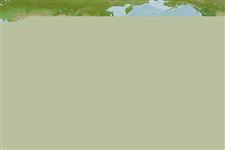Common names from other countries
>
Acanthuriformes (Surgeonfishes) >
Siganidae (Rabbitfishes)
Etymology: Siganus: Latin, siganus = a fish, rabbit fish; by the similarity of the nose (Ref. 45335).
More on author: Bleeker.
Environment: milieu / climate zone / depth range / distribution range
Ecología
marino asociado a arrecife; rango de profundidad 1 - 10 m (Ref. 90102). Tropical; 10°N - 15°S
Western Central Pacific: Indonesia (Java and Moluccas) but probably more widespread (e.g. Palawan; Pohnpei; Andaman Islands).
Tamaño / Peso / Age
Maturity: Lm ? range ? - ? cm
Max length : 25.0 cm TL macho / no sexado; (Ref. 9813)
Espinas dorsales (total) : 13; Radios blandos dorsales (total) : 10; Espinas anales: 7; Radios blandos anales: 9; Vértebra: 13. Golden-red dorsally, paler below. Spine stout, pungent and venomous. Preopercular angle 105° (95°); strong, overlapping scales cover cheeks; midline of thorax scaled, not pelvic ridges. Anterior encircled by a flattened flange or rim, broader posteriorly.
Coastal species which occurs around coral reefs. Probably forms schools. Has herbivorous dentition. Either rare or not being recorded separately from similar species (Ref. 9813). Found in pairs on shallow coastal reefs (Ref. 48637).
Life cycle and mating behavior
Maturities | Reproducción | Spawnings | Egg(s) | Fecundities | Larva
Woodland, D.J., 1990. Revision of the fish family Siganidae with descriptions of two new species and comments on distribution and biology. Indo-Pac. Fish. (19):136 p. (Ref. 1419)
IUCN Red List Status (Ref. 130435)
CITES (Ref. 128078)
Not Evaluated
Threat to humans
Venomous
Human uses
Herramientas
Special reports
Download XML
Fuentes de Internet
Estimates based on models
Preferred temperature (Ref.
115969): 28.5 - 29.2, mean 28.9 (based on 553 cells).
Phylogenetic diversity index (Ref.
82804): PD
50 = 0.5000 [Uniqueness, from 0.5 = low to 2.0 = high].
Bayesian length-weight: a=0.01445 (0.00650 - 0.03213), b=3.08 (2.90 - 3.26), in cm Total Length, based on LWR estimates for this Genus-body shape (Ref.
93245).
Resiliencia (Ref.
120179): Alto, población duplicada en un tiempo mínimo inferior a 15 meses (Preliminary K or Fecundity.).
Fishing Vulnerability (Ref.
59153): Low vulnerability (15 of 100).
